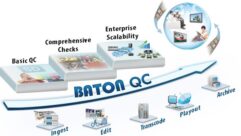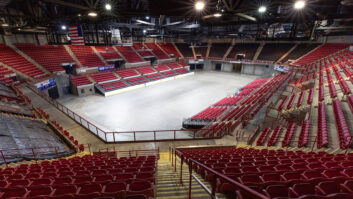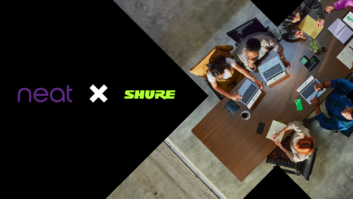INTERNET PROTOCOL and its impact on A-V systems integration
Oct 1, 2000 12:00 PM,
Peter H. Putman
Got IP yet? If those two letters do not immediately strike a chord with you, then read on to learn more about a fundamental shift in the way we will all eventually connect and control audio, video, lighting and other devices. IP control is coming more quickly than you might think, and it will have a real impact on your future business.
IP (Internet Protocol) is a way of describing how packets of data are sent and received along a network. The most recognizable implementation is the Internet, where millions of packets of data are used daily to send text, photos, music, video and financial transactions from one point to another.
The term Internet Protocol simply describes the formal addressing of those data packets and the formats by which they are sent and received. Imagine that you are sitting next to a huge conveyor belt where thousands of letters are rolling past. To your eyes, each letter may appear to be identical, but to a special high-speed scanner (server), the IP address on each individual envelope – a series of numbers like 346.78.246 – provides specific information about what is actually in the envelope (text, video, audio and so on) and where it is supposed to go. That scanner can pick out and accurately route envelopes to their correct destination.
Moreover, the receiver of these envelopes (client) can quickly open and check them, arrange the contents in a particular order, and request another transmission of any missing or damaged data. This process happens at extremely high speeds, ultimately depending upon the bandwidth and speed of the connection between the transmitter and receiver.
Thanks to the digital revolution, almost any type of information can be converted to digital packets. You have probably had firsthand experience with some of these formats. Want to download music from the Web? MP3 music files are simply a collection of IP data packets. Watched any digital television or HDTV lately? These are compressed MPEG-2 files, which are also transmitted as packets.
Okay, you get the packet, I mean, point. So what does this have to do with A-V systems integration? To find out, a comparison of the analog and digital wiring techniques is in order.
Let’s look at a typical, small conference-room video installation. We have a front LCD projector mounted in the ceiling plus computer and video sources. Using analog signal distribution, we will run a five-wire video interface from the computer with another two (or three) wire interface from the DVD player. Stereo audio can travel on its own two-wire runs – one pair for the computer audio input and one for the video input.
We will also run a multi-wire RS-232C interface to control projector functions. Without doing anything else, we have now connected more than 15 wires (in bundles) just to send video and audio to the projector and control its functions remotely.
Now, fast forward to the IP world. A single cable now connects the projector to a server. Down that cable, which can be coaxial, fiber or twisted pair, flows a mixture of audio, video and control signals. Intelligent circuits inside the projector (or in a separate add-on digital-to-analog converter) rapidly decode the mix of data packets, check for errors and send them to the correct processing electronics.
The end result is the same as if we had sent the signals via traditional analog methods. Yet, we have now eliminated several hundred feet of cable. The projector has become a plug-and-play device on a small network connected to a server, or it can be connected to several servers – a DVD server, a computer server, and possibly a personal electronic organizer server.
The projector can even take video and audio information from, and be controlled by, a remote server somewhere else on the network. That network could span several buildings or several miles. As long as the devices use IP interfaces, they can talk to each other and communicate with a host or even multiple hosts on the network.
We are already seeing an intermediate step in the implementation of an IP-type network. Several manufacturers are now selling Cat5 transmitters and receivers, which convert a mix of audio, video and control signals into a multiplexed signal, able to travel over several hundred feet of Cat5 cable without significant attenuation.
The advantage of this system is the simplified wiring required, but these Cat5 converter boxes work with analog input signals, meaning that you will have to run some short harnesses of RGB, video, audio and RS-232 wires from the transmitters and receivers to both signal sources and displays, amps and control ports.
With IP, the signals can remain completely digital from source to destination. IP networks provide a high degree of interactivity, too. You can communicate with an IP device, such as a projector, amp or lighting control device and get an instant update on its status while simultaneously sending video, audio or control data to that device.
How fast can these packets be sent? Local area networks (LANs) can process 100 megabits per second (Mb/s) on Ethernet, and there is a gigabit (1,000 Mb/s) implementation of Ethernet coming. Another fast protocol is called Fibre Channel, and it is used to move data at even higher speeds. Still another network format, known as Asynchronous Transmission (ATM), can zip packets around at 100 Mb/s and more.
That should be fast enough to move compressed electronic cinema from a remote server to a client theater, as demonstrated by companies like Cisco and Panasonic. Therefore, those speeds ought to be fast enough for your IP-based commercial or residential installation.
IP control is slowly gaining momentum, but there is considerable interest from both traditional manufacturers of control devices (Panja, Crestron and Lutron) as well as manufacturers of electronic displays (In Focus and Sony are well along in development of turnkey IP room controls, and other manufacturers like Proxima are close behind).
Does IP control threaten your established systems integration business? If you derive a large part of your income from selling cable, the answer is yes. Otherwise, the answer is probably not. The widespread growth of IP connectivity will have a more adverse affect in the long term on companies that manufacture analog video and audio interfaces; you will not need as many of them if the A-V devices in your network are smart enough and fast enough to process IP packets.
The significance of a company like Sony introducing a networked approach to its A-V components is huge. A Sony dealer will be able to bundle a control system with the sale of a projector and audio components instead of looking to the traditional third-party RS-232C solution. That will help the dealer’s bottom line, but it presents a significant loss of income to those same third-party control system manufacturers.
Now, you may be thinking, “Great! Anyone can run a bunch of phone wire around a room and get into the systems integration business. Where does that leave me?” Hold on; the forecast is not that gloomy. In the IP future, all of the architectural and design elements of a systems integration job will remain largely the same.
What will change is the way you set up your devices to communicate with each other. Instead of an isolated, closed-loop analog control network, you may be connecting devices to a much larger hub within a company, or your residential customer may want his or her new home entertainment system to be controlled via a personal computer that can also download audio and video from the Internet directly to those new audio and video servers.
Granted, the migration to IP control will bring some new competition into your world – namely, those guys who sell computers and deal with LANs and all that wonderfully dull IT stuff. Many of them, however, will not have the broad-based knowledge of audio, video, projection techniques, lighting and architecture that you will bring to the table.
If anything, IP connectivity will make your job (and life) a little easier. For one thing, diagnostics will be greatly improved. You will be able to access your installation via a secure Internet connection and perform a complete troubleshooting job from your desktop,instead of jumping into a car or catching a plane, all the while dreading what you might find.
Your IP diagnostic sessions may reveal the problem to be relatively minor or, at least, easily fixed with an updated control instruction from you. You may also find that a particular, identifiable part needs to be replaced, so you can head out to the job site with exactly the item or items needed to complete the repair.
Any software updates from the manufacture of the equipment can also be downloaded to A-V devices in the installation, again from your remote host server. You can also track use of the facility to determine equipment duty cycles and schedule maintenance.
Not only can a room be booked in advance, but the equipment can also be scheduled to turn on and off automatically when certain conditions are met. Further, multimedia files, such as Microsoft Powerpoint and Macromedia Director presentations, can be downloaded to the projector over the IP network.
Indeed, In Focus is promoting this last feature as the next wave in corporate A-V installations and, in fact, is promoting a shift in responsibility for those facilities to the company’s IT managers from the video guys or corporate communications departments.
Look for the first wave of IP controls and networking products for A-V installations to hit this fall, with more offerings coming by next year’s NSCA and INFOCOMM shows. It would not hurt to bone up a bit on the principles of LANs and IP, either. In the meantime, keep honing all of your knowledge of audio and video systems. Lenses, loudspeakers, screens, mics, lights and interior furnishings are not going to wind up digital any time soon.










